-
数据库查询详解
数据库查询操作
前置:首先我们创建一个练习的数据库
/* SQLyog Professional v12.09 (64 bit) MySQL - 5.6.40-log : Database - studentsys ********************************************************************* */ /*!40101 SET NAMES utf8 */; /*!40101 SET SQL_MODE=''*/; /*!40014 SET @OLD_UNIQUE_CHECKS=@@UNIQUE_CHECKS, UNIQUE_CHECKS=0 */; /*!40014 SET @OLD_FOREIGN_KEY_CHECKS=@@FOREIGN_KEY_CHECKS, FOREIGN_KEY_CHECKS=0 */; /*!40101 SET @OLD_SQL_MODE=@@SQL_MODE, SQL_MODE='NO_AUTO_VALUE_ON_ZERO' */; /*!40111 SET @OLD_SQL_NOTES=@@SQL_NOTES, SQL_NOTES=0 */; CREATE DATABASE /*!32312 IF NOT EXISTS*/`studentsys` /*!40100 DEFAULT CHARACTER SET utf8 */; USE `studentsys`; /*Table structure for table `course` */ DROP TABLE IF EXISTS `course`; CREATE TABLE `course` ( `cno` varchar(10) NOT NULL, `cname` varchar(20) NOT NULL, `credit` int(2) DEFAULT NULL, PRIMARY KEY (`cno`) ) ENGINE=InnoDB DEFAULT CHARSET=utf8; /*Data for the table `course` */ insert into `course`(`cno`,`cname`,`credit`) values ('C01','网页基础',1),('C02','数据库系统',2),('C03','计算机基础',3); /*Table structure for table `dept` */ DROP TABLE IF EXISTS `dept`; CREATE TABLE `dept` ( `did` int(11) NOT NULL AUTO_INCREMENT, `dname` varchar(20) NOT NULL, PRIMARY KEY (`did`) ) ENGINE=InnoDB AUTO_INCREMENT=4 DEFAULT CHARSET=utf8; /*Data for the table `dept` */ insert into `dept`(`did`,`dname`) values (1,'计算机系'),(2,'土木工程系'),(3,'英语系'); /*Table structure for table `sc` */ DROP TABLE IF EXISTS `sc`; CREATE TABLE `sc` ( `sno` varchar(10) DEFAULT NULL, `cno` varchar(10) DEFAULT NULL, `degree` int(3) DEFAULT NULL ) ENGINE=InnoDB DEFAULT CHARSET=utf8; /*Data for the table `sc` */ insert into `sc`(`sno`,`cno`,`degree`) values ('S01','C01',80),('S01','C02',85),('S01','C03',90),('S02','C01',63),('S02','C02',58),('S03','C01',55),('S03','C03',65),('S04','C01',58); /*Table structure for table `student` */ DROP TABLE IF EXISTS `student`; CREATE TABLE `student` ( `sno` varchar(10) NOT NULL, `sname` varchar(20) NOT NULL, `sex` char(4) DEFAULT NULL, `age` int(11) DEFAULT NULL, `brithday` datetime DEFAULT NULL, `address` varchar(200) DEFAULT NULL, `did` int(11) DEFAULT NULL, PRIMARY KEY (`sno`) ) ENGINE=InnoDB DEFAULT CHARSET=utf8; /*Data for the table `student` */ insert into `student`(`sno`,`sname`,`sex`,`age`,`brithday`,`address`,`did`) values ('S01','陈宇乐','男',21,'2022-02-02 00:00:00','浙江义乌',1),('S02','陈紫樱','女',20,'2022-02-10 00:00:00','',1),('S03','杜陈宇','男',21,NULL,NULL,1),('S04','陈宇乐','男',23,NULL,NULL,2),('S05','陈樱','女',21,NULL,NULL,2),('S06','杜佳佳','男',19,NULL,NULL,NULL); /*!40101 SET SQL_MODE=@OLD_SQL_MODE */; /*!40014 SET FOREIGN_KEY_CHECKS=@OLD_FOREIGN_KEY_CHECKS */; /*!40014 SET UNIQUE_CHECKS=@OLD_UNIQUE_CHECKS */; /*!40111 SET SQL_NOTES=@OLD_SQL_NOTES */;- 1
- 2
- 3
- 4
- 5
- 6
- 7
- 8
- 9
- 10
- 11
- 12
- 13
- 14
- 15
- 16
- 17
- 18
- 19
- 20
- 21
- 22
- 23
- 24
- 25
- 26
- 27
- 28
- 29
- 30
- 31
- 32
- 33
- 34
- 35
- 36
- 37
- 38
- 39
- 40
- 41
- 42
- 43
- 44
- 45
- 46
- 47
- 48
- 49
- 50
- 51
- 52
- 53
- 54
- 55
- 56
- 57
- 58
- 59
- 60
- 61
- 62
- 63
- 64
- 65
- 66
- 67
- 68
- 69
- 70
- 71
- 72
- 73
- 74
- 75
- 76
- 77
- 78
- 79
- 80
- 81
- 82
- 83
- 84
- 85
- 86
1 查询基础
1.1 select 操作
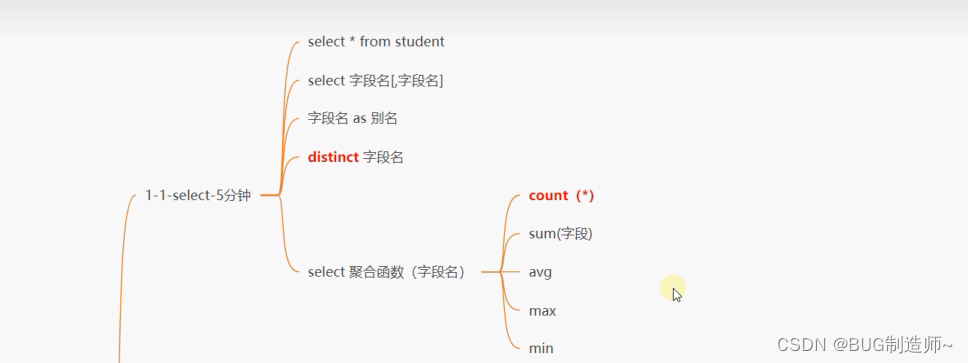
参考sql
#查询所有学生信息 select * from student; #查询学生表中的学号与姓名 select sno,sname from student; #查询学生表中的学号与姓名,并且给一个字段别名 select sno as snum,sname as `姓名` from student; #查询学生表中的姓名信息,并过滤掉相同姓名信息 select distinct sname from student; #查询学生个数,年龄总和,平均年龄,最大年龄,最小年龄,并给他们一个别名 select count(*) as `学生个数` ,sum(age) as `年龄总和` from student; select avg(age) as `平均年龄` ,max(age) as `最大年龄`,min(age) as `最小年龄` from student;- 1
- 2
- 3
- 4
- 5
- 6
- 7
- 8
- 9
- 10
- 11
- 12
- 13
- 14
- 15
- 16
- 17
1.2 where

参考SQL#查询所有男生的信息 select * from student where `sex`="男"; #查询所有21岁男生的信息 select * from student where `sex`="男" and age = 21;- 1
- 2
- 3
- 4
- 5
- 6
- 7
- 8
1.3 模糊查询
参考SQL
#查询姓‘陈’的同学 select * from student where sname like '陈%'; #查询名字中出现‘陈’的同学 select * from student where sname like '%陈%'; #查询姓陈的二个字姓名的同学 select * from student where sname like '陈_'; #查询名字结尾是‘樱’的三个字姓名的同学 select * from student where sname like '__樱';- 1
- 2
- 3
- 4
- 5
- 6
- 7
- 8
- 9
- 10
- 11
1.4 排序
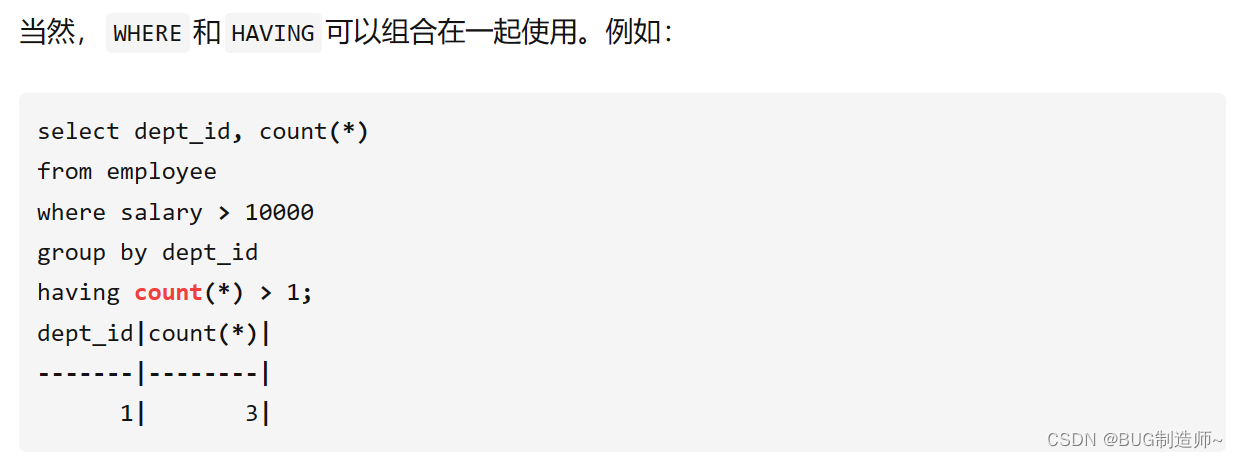
参考SQL
#根据学生年龄从大到小进行排序学生信息 select * from student order by age desc; #根据学生年龄从小到大进行排序'男'同学信息 select * from student where sex='男' order by age; #第一排序根据学生年龄升序进行排序,第二排序根据‘学号’降序排序的同学信息 select * from student order by age asc , sno desc;- 1
- 2
- 3
- 4
- 5
- 6
- 7
- 8
- 9
1.5 分组与having子句

参考SQL
#分组一般和聚合函数一起使用 #根据性别进行分组,并分别统计各组的人数 select sex,count(*) as `人数` from student group by sex; #根据性别进行分组,并分别统计各组的同学的平均年龄 select sex,avg(age) as `平均年龄` from student group by sex; #HAVING子句 一般是配合GROUP BY使用 #根据性别进行分组,并统计各组的人数大于3人的分组信息 select sex,count(*) as `性别组` from student group by sex having `性别组` > 3- 1
- 2
- 3
- 4
- 5
- 6
- 7
- 8
- 9
- 10
- 11
- 12
having 和 where 的区别
WHERE与HAVING的根本区别在于:
WHERE子句在GROUP BY分组和聚合函数之前对数据行进行过滤;
HAVING子句对GROUP BY分组和聚合函数之后的数据行进行过滤。
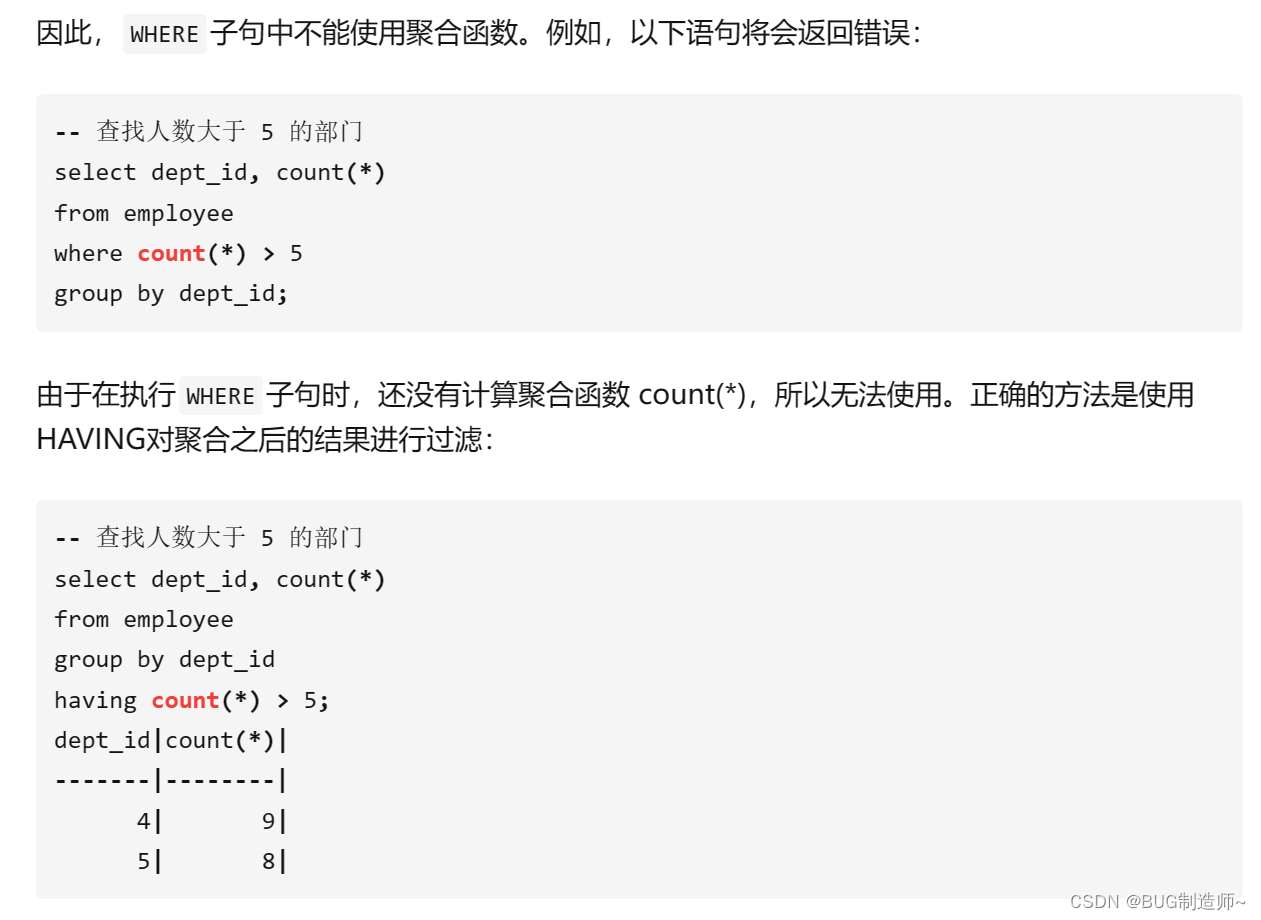
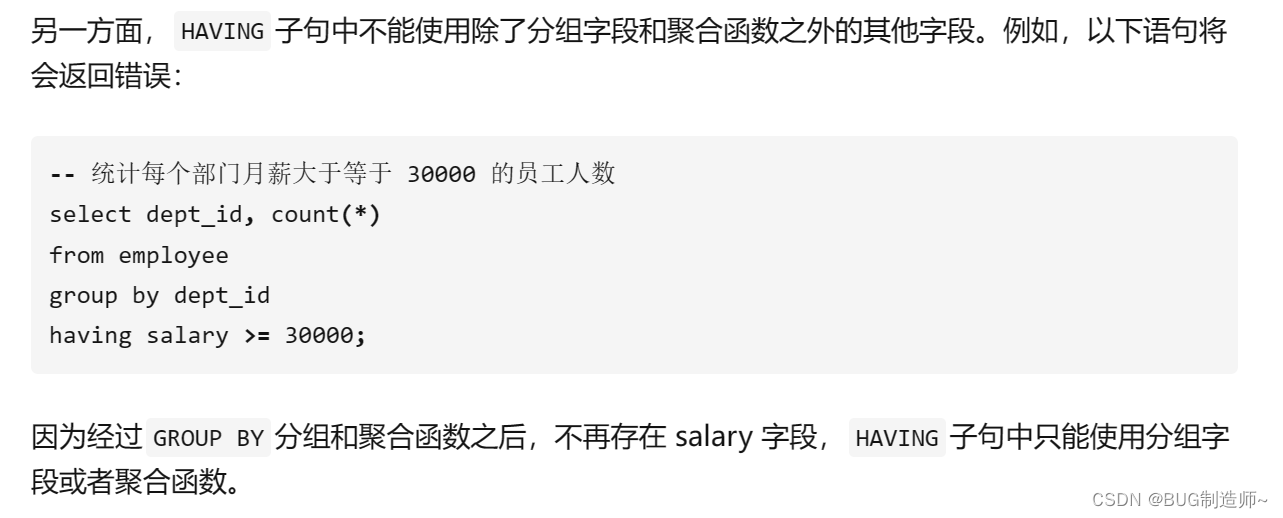

1.6 限制显示条数-limit
参考SQL
#显示学生表信息的前3条 select * from student limit 3; #显示学生表信息的2-4条 select * from student limit 1,3; #显示年龄第2大和第3大的"男"学生 select * from student where sex='男' order by age desc limit 1,2;- 1
- 2
- 3
- 4
- 5
- 6
- 7
- 8
2 比较逻辑运算
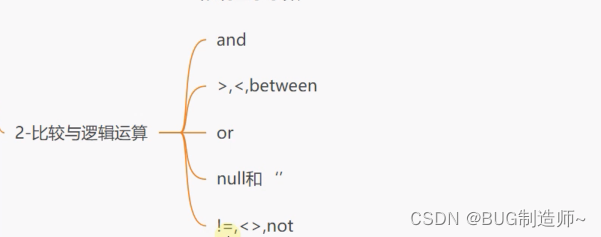
参考SQL
#查询年龄大于20岁小于23岁的男生 select * from student where age > 20 and age < 23 and sex='男'; #区间的另一种写法 BETWEEN 大于等于20岁小于等于23岁 select * from student where sex='男' and age between 20 and 23; #查询性别是男,或者年龄大于等于21岁的学生 select * from student where sex='男' or age >= 21; #查询地址为''的学生信息 select * from student where address = ''; #查询地址为null的学生信息,和is搭配 select * from student where address is null; #查询年龄不是21岁的学生 select * from student where age != 21; select * from student where age <> 21; #查询地址不为null的学生信息 select * from student where address is not null;- 1
- 2
- 3
- 4
- 5
- 6
- 7
- 8
- 9
- 10
- 11
- 12
- 13
- 14
- 15
- 16
- 17
- 18
- 19
- 20
3 多表连接

3.1 内连接
参考SQL
#显示拥有系别学生学号,姓名,及所在系名称-[内连接方式] select s.sno,s.sname,d.dname from student s inner join dept d on s.did = d.did; #不推荐写法 select s.sno,s.sname,d.dname from student s ,dept d where s.did = d.did;- 1
- 2
- 3
- 4
- 5
3.2 左连接
参考代码
#显示所有学生信息,及所在系情况-[左连接/左外连接] #左连接已左边的表为主 select s.sno,s.sname,d.dname from student s left join dept d on s.did = d.did;- 1
- 2
- 3
- 4
3.3 右连接
参考代码
#右连接/右外连接 select s.*,d.dname from student s right join dept d on s.did = d.did- 1
- 2
- 3
3.4 全连接
MYSQL不支持FULL JOIN
select s.*,d.dname from student s left join dept d on s.did = d.did union select s.*,d.dname from student s right join dept d on s.did = d.did;- 1
- 2
- 3
3.5 综合案例
#查询已选课学生姓名,课程名称,课程成绩 select st.sname,c.cname,sc.degree from sc left join student st on sc.sno = st.sno inner join course c on sc.cno = c.cno; #查询至少选修一门课的女同学姓名,除去重复姓名项 select st.sname,sc.degree from sc join student st on sc.sno = st.sno where st.sex = '女';- 1
- 2
- 3
- 4
- 5
- 6
- 7
- 8
- 9
4 子查询

4.1 =
SQL代码
#查询和'陈樱'同龄的学生信息 select * from student where age = ( select age from student where sname = '陈樱' );- 1
- 2
- 3
- 4
- 5
4.2 in/not in
SQL代码
#查询课程成绩不及格的选修课课程信息 select * from course where cno in ( select distinct cno from sc where degree < 60 ); #查询课程成绩及格的选修课课程信息 select * from course where cno not in ( select distinct cno from sc where degree < 60 ); #in或者not in一般来说查询效率低,采用多表连接 select distinct c.cname from sc join course c on sc.cno = c.cno where sc.degree < 60;- 1
- 2
- 3
- 4
- 5
- 6
- 7
- 8
- 9
- 10
- 11
- 12
- 13
- 14
4.3 all
满足所有条件
SQL代码#ALL表示必须满足子查询结果的所有记录 #查询sc表里成绩最高的记录 select * from sc where degree >= ALL (select degree from sc); #查询sc表里成绩最低的记录 select * from sc where degree <= ALL (select degree from sc);- 1
- 2
- 3
- 4
- 5
- 6
- 7
4.4 any
满足其中的一个条件
SQL代码#any表示满足子查询结果的任意一条记录即可,和some一样 #查询选择’C01‘课程的成绩高于’C02‘的成绩的学生的学号 select * from sc where cno = 'C01' and degree > any( select degree from sc where cno = 'C02' ); select * from sc where cno = 'C01' and degree > some( select degree from sc where cno = 'C02' );- 1
- 2
- 3
- 4
- 5
- 6
- 7
- 8
- 9
- 10
4.5 exist/not exists
SQL代码
#EXISTS子查询返回结果类型bool #EXISTS运算符的含义为"存在", #使用 EXISTS 关键字引入一个子查询时,就相当于进行一次存在测试。 #外部查询的 WHERE 子句测试子查询返回的行是否存在。 #子查询实际上不产生任何数据;它只返回 TRUE 或 FALSE 值 #显示已经选修了课程的学生信息 select distinct s.* from student s inner join sc on sc.sno = s.sno; select * from student s where exists (select * from sc where s.sno = sc.sno); #查询选修了C03课程的学生信息 select * from student s where exists (select * from sc where s.sno = sc.sno and sc.cno = 'C03');- 1
- 2
- 3
- 4
- 5
- 6
- 7
- 8
- 9
- 10
- 11
- 12
- 13
- 14
- 15
- 16
- 17
-
相关阅读:
Java深入理解线程的三大特性
使用Flask和Flask-JWT-Extended保护API免受跨站请求攻击
前端组件封装:构建模块化、可维护和可重用的前端应用
MidJourney笔记(2)-面板使用
在ITSM中,实施变更管理的重要因素!
微信小程序开发前准备
Linux--信号携带消息
字符编码
论文管理系统(增删查改功能的实现)
Vue+element 商品分类业务实现
- 原文地址:https://blog.csdn.net/nidayededaye2/article/details/133547645
